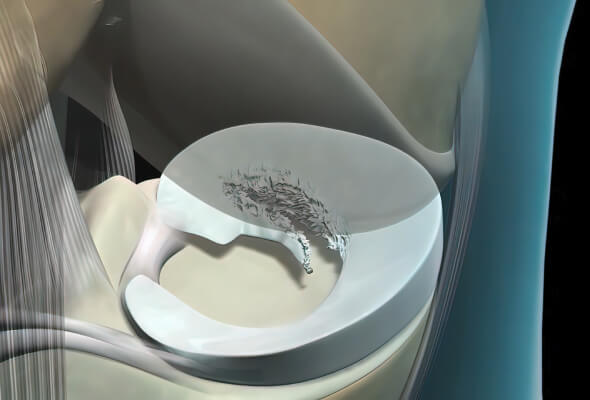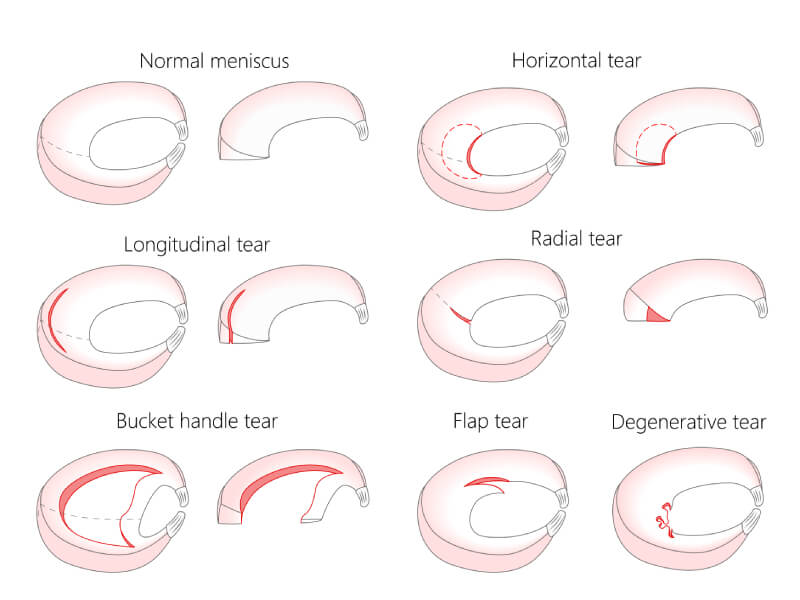Knee Meniscus Tears
Introduction to Knee Meniscal Tears
A knee injury often involves damage to ligaments, tendons, cartilage, bones, or muscles that support the knee joint. These injuries can be caused by falling, twisting the knee, a high impact collision, or other factors.
Sprains, ligament injuries and dislocations are the most common knee injuries.
Knee Meniscus tears are one of the most common sporting injuries affecting the knee.
What is a Knee Meniscus Tear?
A meniscus tear is a common knee injury that can be caused by a sudden twisting motion or a direct impact on the knee. The meniscus is a C-shaped piece of cartilage that helps to cushion and stabilize the knee joint.
The C shaped Meniscus has two horns, anterior and posterior
A meniscus tear occurs when the meniscus is damaged or degenerates over time.

The most common type of meniscal tear is called a radial tear, which occurs when the outer edge of the meniscus tears away from its attachment to the bone.
Bucket handle tears are less common and occur when there is a tear to one side of the meniscus (medial meniscus) near its attachment to bone.
Incidence of Knee Meniscal Tears:
Symptoms of a Meniscal Tear:
Usually, a “pop” or other sound is heard or felt if your meniscus is torn. Initially the knee is quite painful but this may ease over the course of the following weeks and many patients find they can still walk on their injured knee.
Other indications of a torn meniscus include:
- Knee pain: can range in intensity from mild to severe and come and go
- Swelling: typically develops several hours after a meniscus injury,
- A sensation that your knee is catching or locking, usually when it's bent, and you may hear it click
- A sensation that your knee is unstable and about to give way
- An inability to fully bend and extend your knee, and
Causes of a Knee Meniscus Tear:
4 Types of Meniscal Tear:

- Radial Meniscus Tear: Meniscus tears that outstretch radially from the free rim of a meniscus across its short axis are called radial meniscal tears
- Bucket Handle Meniscus Tear: The inner part of displaced meniscus tears are called bucket handle meniscus tears. They often affect the medial meniscus and are frequently linked to ACL (Anterior Cruciate Ligament) tears at the same time.
- Degenerative Meniscus Tears: These are caused by repeated normal forces pressing against a meniscus that is already ‘worn’. It can also be caused by osteoarthritis or any previous tear.
- Posterior Horn Medial Meniscus Tear: The section of the medial meniscus in the rear of the knee is called the posterior horn. The posterior horn is the most significant weight-bearing component of the meniscus. In this way it is a major shock absorber of the knee.
4 Types of Meniscal Tear:
- Radial Meniscus Tear: Meniscus tears that outstretch radially from the free rim of a meniscus across its short axis are called radial meniscal tears
- Bucket Handle Meniscus Tear: The inner part of displaced meniscus tears are called bucket handle meniscus tears. They often affect the medial meniscus and are frequently linked to ACL (Anterior Cruciate Ligament) tears at the same time.
- Degenerative Meniscus Tears: These are caused by repeated normal forces pressing against a meniscus that is already ‘worn’. It can also be caused by osteoarthritis or any previous tear.
- Posterior Horn Medial Meniscus Tear: The section of the medial meniscus in the rear of the knee is called the posterior horn. The posterior horn is the most significant weight-bearing component of the meniscus. In this way it is a major shock absorber of the knee.
Which Meniscus Tear is most commonly Injured?
Why is a Meniscus Tear Common in Athletes?
Diagnosis of a Meniscus Tear:
Diagnosis of a Meniscus tear is based on physical examination and imaging tests.
We will go through both the methods in detail to understand the diagnosis process:
Physical Examination: After taking a thorough medical history, the doctor may perform a thorough knee examination to check for stability and pain in the knee.
The joint is checked for tenderness along its joint line which may indicate meniscus irritation or damage
- The McMurray test is one of the primary examinations for meniscus injuries. Your knee will be flexed by your doctor before it is straightened and rotated. A meniscus tear is put under stress by this. If you have a meniscus tear, this movement may hurt, ‘click’, or make the joint seem ‘clunky’.
Imaging Tests/Scans:
- MRI: The menisci, cartilage, tendons, and ligaments in your knee joint are all evaluated by an MRI scan.
- X-ray: Although an X-ray does not reveal a torn meniscus, your doctor may still prescribe one to rule out causes of the pain such as osteoarthritis or a loose body.
What Are The Treatment Options Available?
Your age, your symptoms, and your degree of activity will all affect the course of treatment.
To devise the best treatment plan, the doctor will consider the extent and severity of the tear.
The meniscus’s outer portion has a plentiful blood supply. A tear in this “red” zone may recuperate on its own or frequently require surgery to be corrected. This form of tear includes longitudinal tears.
In contrast, there isn’t much blood flow to the inner two-thirds of the meniscus. Tears in this “white” zone of restricted blood flow cannot heal without the nutrients from the blood.
Symptomatic tears in this zone that do not respond to conservative treatment are typically surgically repaired as the prognosis can be ‘early’ arthritis and constant knee pain without surgery.
Non-Surgical or Conservative Management Options
RICE Approach
The majority of sports-related injuries can be treated with the RICE regimen. Rest, ice, compression, and elevation stand for RICE.
- Rest: Crutches may be suggested by your doctor if you want to avoid putting weight on your injured leg
- Ice: Applying cold packs for 20 minutes at a time, several times a day might help
- Compression: Wear a compression bandage that is stretchy to stop blood loss and extra swelling. It may also improve the joint position and hence balance
- Elevation: When you're resting, lean back and elevate one leg over the other to reduce swelling.
- NSAIDs: Non-steroidal anti-inflammatory drugs are also helpful in alleviating pain and swelling
- Steroid Injections: Steroid injections are more effectively used for reducing pain and swelling
- PRP: Platelet-Rich Plasma (PRP) is an example of biological injections that are under study, and shows promising results for meniscus tear treatment. As there is poor flow in the deep meniscus, PRP injections help the platelets reach the lesion and help the repair process.
- Prolotherapy: A Regenerative treatment consisting of dextrose which has shown great promise in healing knee meniscal tears
- Hyaluronic acid: A Regenerative Treatment called viscosupplementation that is injected into the joint. A mechanically engineered synovial fluid with lubricating properties which helps improve knee joint pain and stiffness
NSAIDs
- Non-steroidal anti-inflammatory drugs are also helpful in alleviating pain and swelling
Steroid Injections
- Steroid injections are more effectively used for reducing pain and swelling
PRP
- Platelet-Rich Plasma (PRP) is an example of biological injections that are under study, and shows promising results for meniscus tear treatment. As there is poor flow in the deep meniscus, PRP injections help the platelets reach the lesion and help the repair process.
Prolotherapy
- A Regenerative treatment consisting of dextrose which has shown great promise in healing knee meniscal tears
Hyaluronic acid
- A Regenerative Treatment called viscosupplementation that is injected into the joint. A mechanically engineered synovial fluid with lubricating properties which helps improve knee joint pain and stiffness
Surgical Options:
- Knee Arthroscopic repair: In this treatment, the surgeon makes a tiny incision in the knee and puts a miniature camera through it. This makes it possible to see the inside of the knee clearly. The surgeon will then trim or suture the tear.
- Partial Meniscectomy: This procedure aims to restore muscle strength and a full range of motion. It involves the trimming of damaged meniscus tissue.
- Knee brace for meniscus tear: A knee brace is not directly involved in the repair or healing of a meniscal tear, however, it is used to provide adequate support and stability that promotes faster healing. The knee brace helps to take the load off of the meniscus and reduce pain. These devices are termed knee ‘off loader’ devices and take pressure off the injured meniscus whilst it heals.
Prevention of a Meniscal Tear:
- Make your knees supporting and stabilizing muscles stronger. Stronger Quadriceps including the Vastus Medialis Oblique (VMO) and Gluteal Muscles can help prevent the knee twisting or buckling during high impact activities.
- If you are aware that your knee is unstable or weak, wear a knee brace
- Increase your exercise intensity gradually
- Put on sports shoes that are appropriate for the exercise you're engaging in.
What is the Prognosis for People with Meniscal Tears?
The prognosis for a meniscus tear or any knee injury is variable.
Most of the time, people who damage their knee meniscus recover and return to previous activity.
In the case of meniscal repair surgery, the recovery is quick, and the knee takes weeks rather than months to improve.
Conclusion
A torn meniscus is a common knee injury. Typically, it happens when your knee suddenly twists under load or during high impact trauma like tackling in football.
Playing sports, working out, or simply twisting your knee in everyday activities can result in a torn meniscus.
While some minor meniscus tears can heal on their own with good physical rehab, others could need regenerative injections such as Prolotherapy, PRP or Hyaluronic surgery.
For an assessment of your Knee and any meniscus injury
Contact us
We’d love to hear from you!
Just reach out and contact us via any of
these channels:

Call us on

Email us on

Call us on





